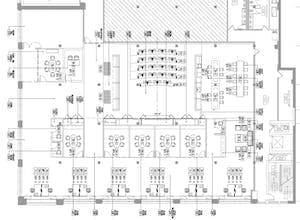
The first time you opened a set of architectural plans, you were probably instantly lost and confused. If you are managing your company’s real estate project, but don’t have any real training in architecture, reading these plans can be extremely difficult. To save you some time and trouble, we’ve put together a guide as to how to read architectural plans.
We talked to one of our Senior Project Managers, Natalie Malawey-Ednie. Natalie is a registered architect and also teaches architecture. Her recommendation to us, and to her students, is to first take a step back and understand what a plan is. Natalie says to “Picture your building or your space. Then imagine that a few feet above the floor, you are slicing away everything else and looking at your space as if you are hovering above it.”
Here are a few additional general guidelines to keep in mind:
- Be organized and diligent when reading plans. Start in upper left corner and work way across page so as not to miss any details.
- Read the plan cover sheet. This contains important project information like the project name, architect, contact information, project information and the date. It might also include a drawing of the finished product.
- There are often reference points that are used between professionals and sets of drawings. These can come in many forms: room numbers, a grid system, structural references, etc.
- Review the plan index which provides a list of all plan sheets.
Start with the Site or Plot plan. This provides an overhead view of the property and details about the boundaries and orientation of the building. There will also be a symbol legend will depict the symbols used to indicate windows, doors, elevation, etc. Many symbols contain numbers within them which refer to the section and the page number of the plans. Reviewing the symbol legend will help when looking at the actual plans so that you recognize what the symbols are referring to. You may also want to review the list of abbreviations, many of which are standard in the industry, but some may be specific to the architect. This will also help later when you are reading design notes.

Once you move into reading the actual architectural sheets, it’s important to know that architectural plans are labeled with an A (A 001 or A1-X, A2-X, etc.). The architectural plans are where you will see where your office is, where the bathrooms are in relation to workstations, etc. They will also provide measurements, elevations, locations of walls, windows, bathrooms, etc. Plans are broken up into many, many parts so it’s make sure to look at the plan number (and North arrow) to help orient yourself. Always read the notes on a page! Some design details are easier to communicate via text so notes are included on the drawing or sometimes as additional pages.
There are many additional plans that supplement architectural plans: ceiling, roof framing, finish schedule (paint colors for each wall, flooring type and color, ceiling height, type, and color), door/window schedule, and many more. These plans contain important details, but we will cover those details in a future blog post. For now, hopefully this will help the next time you’re trying to figure out how to read architectural plans.

